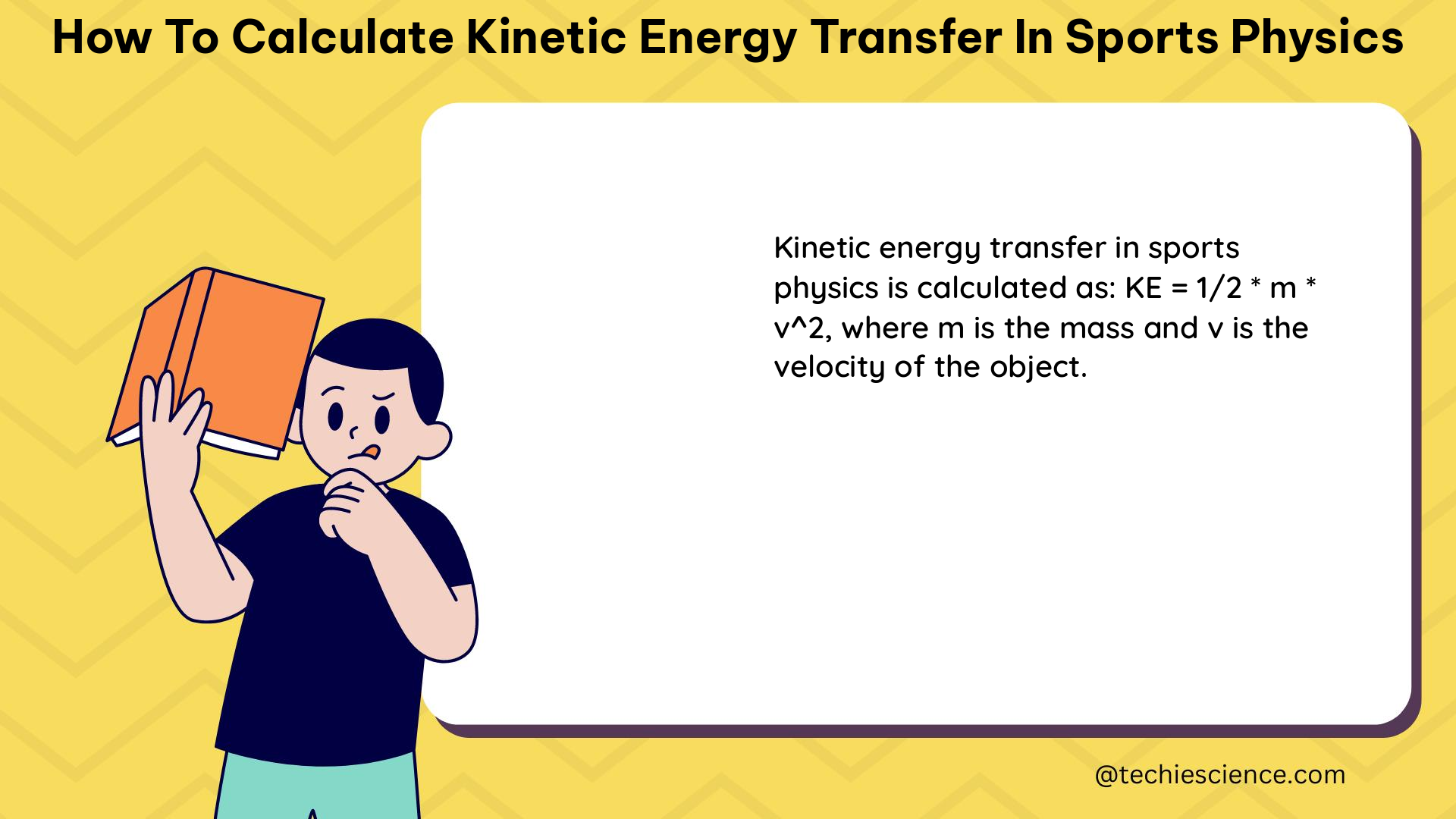The transfer of kinetic energy is a crucial concept in sports physics, as it helps us understand the impact of collisions, hits, and other dynamic interactions between objects. By understanding the principles of kinetic energy transfer, we can analyze and optimize athletic performance, as well as gain insights into the underlying physics behind various sports.
Understanding Kinetic Energy
Kinetic energy is the energy possessed by an object due to its motion. The formula for calculating kinetic energy (EK) is:
EK = 1/2 * M * V^2
Where:
– M is the mass of the object
– V is the velocity of the object
This equation shows that the kinetic energy of an object is directly proportional to its mass and the square of its velocity. Increasing either the mass or the velocity of an object will result in a higher kinetic energy.
Factors Affecting Kinetic Energy Transfer

In sports, the transfer of kinetic energy occurs during various interactions, such as:
- Collisions: When two objects collide, the kinetic energy of one object can be transferred to the other, causing changes in their velocities and directions.
- Impacts: When an object strikes another object, the kinetic energy of the striking object can be transferred to the struck object, resulting in a change in the struck object’s motion.
- Swings and Kicks: In sports like baseball, golf, and soccer, the kinetic energy of the player’s swing or kick is transferred to the ball, giving it a high velocity and distance.
The amount of kinetic energy transferred during these interactions depends on several factors:
- Mass: The mass of the objects involved in the interaction. Heavier objects will have more kinetic energy to transfer.
- Velocity: The velocity of the objects involved in the interaction. Higher velocities will result in higher kinetic energies.
- Angle of Contact: The angle at which the objects make contact can affect the efficiency of the kinetic energy transfer.
- Surface Area of Contact: The surface area over which the objects make contact can also influence the kinetic energy transfer.
- Duration of Contact: The length of time the objects are in contact can affect the amount of kinetic energy transferred.
Calculating Kinetic Energy Transfer
To calculate the kinetic energy transfer in sports physics, follow these steps:
- Measure the Mass: Determine the mass of the objects involved in the interaction, such as the ball, bat, or player.
- Measure the Velocities: Measure the velocities of the objects before and after the interaction using sensors, cameras, or other measurement techniques.
- Calculate the Initial Kinetic Energy: Use the formula EK = 1/2 * M * V^2 to calculate the initial kinetic energy of the objects.
- Calculate the Final Kinetic Energy: Use the formula EK = 1/2 * M * V^2 to calculate the final kinetic energy of the objects after the interaction.
- Determine the Change in Kinetic Energy: Subtract the final kinetic energy from the initial kinetic energy to find the change in kinetic energy, which represents the amount of kinetic energy transferred.
Here are some examples of kinetic energy transfer calculations in sports:
Example 1: Soccer Ball Kick
A soccer player kicks a stationary soccer ball with a mass of 0.45 kg and a velocity of 25 m/s.
Initial kinetic energy of the soccer ball:
EK = 1/2 * 0.45 kg * (25 m/s)^2 = 787.5 Joules
Example 2: Baseball Bat Swing
A baseball player hits a baseball with a mass of 0.145 kg and a velocity of 40 m/s.
Kinetic energy of the baseball:
EK = 1/2 * 0.145 kg * (40 m/s)^2 = 117.6 Joules
Example 3: Hockey Puck Hit
A hockey puck with a mass of 0.17 kg is sliding on ice at a velocity of 30 m/s. A player hits the puck, giving it a final velocity of 40 m/s.
Change in kinetic energy of the hockey puck:
EK_final = 1/2 * 0.17 kg * (40 m/s)^2 = 136.0 Joules
EK_initial = 1/2 * 0.17 kg * (30 m/s)^2 = 76.5 Joules
Change in EK = EK_final – EK_initial = 136.0 – 76.5 = 28.1 Joules
Example 4: Golf Ball Drive
A golfer hits a golf ball with a mass of 0.046 kg and a velocity of 70 m/s. The golf ball travels a distance of 200 meters before stopping.
Assuming no air resistance, the change in kinetic energy of the golf ball is equal to the work done by the golfer’s swing. The work done by the swing is equal to the force applied times the distance traveled. Assuming a constant force, we can calculate the work done as:
Work = Force * Distance = (0.046 kg * 70 m/s^2) * 200 m = 6270 Joules
Therefore, the change in kinetic energy of the golf ball is 6270 Joules.
Conclusion
Calculating the kinetic energy transfer in sports physics is essential for understanding the dynamics of various sports and optimizing athletic performance. By measuring the mass and velocity of the objects involved, as well as considering other factors like angle of contact, surface area, and duration of contact, you can determine the amount of kinetic energy transferred during different sports interactions. This knowledge can help coaches, athletes, and sports scientists improve training techniques, equipment design, and overall athletic performance.
References
- Kinetic Energy and Velocity Lab – Arbor Scientific
- Kinetic Energy and the Work-Energy Theorem | Physics – Lumen Learning
- Calculate the Kinetic Energy of a Moving Object | Physics – Study.com
- Speed and Kinetic Energy of Sports Pitches, Shots and Kicks – Engaging-Data.com
- How To Calculate Kinetic Energy – Physics GCSE – YouTube
